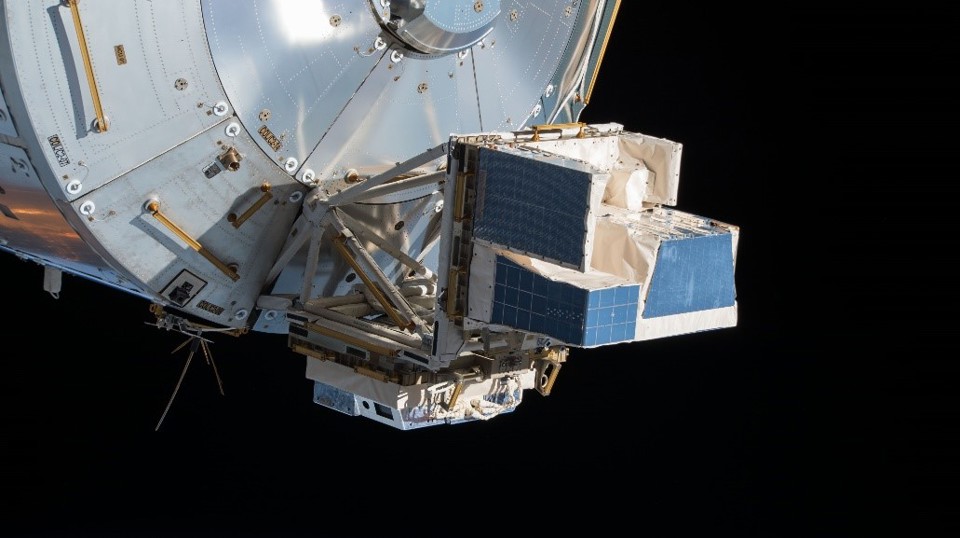2019-04-09
NEW KNOWLEDGE ABOUT GIANT LIGHTNING BOLTS IN SPACE
Measurements from the large ASIM space project show a firework of blue lightning and X-ray radiation above thunderclouds.

After one year in space, the ASIM (Atmosphere-Space Interactions Monitor) observatory on the International Space Station (ISS) has given researchers from Denmark’s Technical University (DTU) a new understanding of how lightning is created, and how thunderstorms can affect the stratosphere and the climate.
The first measurements show what creates the so-called ‘terrestrial gamma-flashes’ in the atmosphere. The flashes occur in connection with lightning and thunderstorms and are short bursts of high-energy X- and gamma- rays. At the same time, the researchers have received measurements showing a wealth of blue lightning above the thunderclouds.
The discoveries have just been published at a European Geosciences Union (EGU) conference in Vienna. During the year, DTU researchers will describe the results of the research in a number of scientific articles. Here, it will be evident how lightning creates these ‘terrestrial gamma-flashes’ that were discovered back in 1993.
“We can really see new things and have gained so much knowledge on the internal anatomy of the lightning. Besides the ‘terrestrial gamma-flashes’, our recordings show lots of blue lightning that spread like fireworks above thunderclouds. It looks crazy,” says Torsten Neubert, lead scientist for the ASIM project and Senior Executive Officer at DTU Space.
He is pleased that ASIM lives up to expectations. The observatory was sent to the ISS on 2 April 2018 to monitor the violent thunderstorms and lightning that appear above the clouds and uncover the invisible processes that drive them.
One of the invisible processes are gamma-ray flashes from thunder and lightning. A phenomenon known as terrestrial gamma-ray flashes (TGFs). ASIM is also investigating energy discharges driven by thunderstorms in the area from the top of the clouds and up to 100 km above the ground.

The zoo of upper atmospheric phenomena powered by thunderstorms. Terrestrial Gamma Ray Flashes (TGFs) are burst of gamma-rays from thunderstorms accompanied by energetic electrons and positrons. Transient Luminous Emissions (TLEs) are electrical discharges that include the blue glimpses at the top of thunderstorms, the blue jet, gigantic jet and the red sprite. TLEs also include elves, the rapidly expanding rings of emissions at the bottom ionosphere, and the haloes. Credit: DTU Space; TGF: NASA.
Highlight for Andreas Mogensen
Already back in 2015, the Danish ESA astronaut Andreas Mogensen succeeded in filming a spectacular thunderstorm over the Indian Ocean while on board the ISS. Here, he caught a so-called Blue Jet that can reach altitudes of 50 km. But that was not all. For the first time, the Blue Jet was seen pulsating. This means that the lightening fires upwards several times in quick succession. He also caught a lot of blue flashes near the top of the cloud.
The recordings were important for DTU – partly because they are the best shots ever taken – partly because they are taken from an angle that makes it easier for researchers to understand what is happening.
“ASIM is an excellent example of the exciting and important research we carry out aboard the International Space Station. Research that will contribute with new knowledge about our world. Filming the blue lightning was undoubtedly one of the highlights of my mission in 2015,” says Andreas Mogensen.
Update enhances accuracy
For the past six months, the Danish company Terma, who heads the technical part of the project, has completed an upgrade of the computer programs that control ASIM’s two main instruments. One of the instruments is the MXGS (Modular X- and Gamma-ray Sensor). The second instrument – the Modular Multi-spectral Imaging Array (MMIA) – consists of two cameras and three photometers that detect flashes of light at different wavelengths.
“The updates will give the researchers better measurements because the instruments have become more sensitive in relation to capturing gamma radiation and gigantic lightning above the clouds. It will also improve the time accuracy between the two instruments to better than ten millionths of a second, which again will improve the analysis of the signals from the many sensors,” says Senior Project Manager Ole Hartnack from Terma.
The excellent data means that DTU researchers consider applying for an extension of the mission beyond the planned duration of two years. It will also offer an opportunity to study the Northern Lights and meteors.
Learn more
Lead Scientist, ASIM and Senior Executive Officer at DTU Space
Torsten Neubert
+45 2622 4265 neubert@space.dtu.dk
Who we are
Terma in Brief
The Denmark based high-tech Terma Group develops products and systems for defense and non-defense security applications; including command and control systems, radar systems, self-protection systems for aircraft, space technology, and aerostructures for the aircraft industry.
Learn more about us



